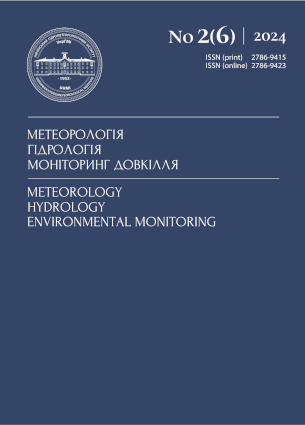Manifestations of the interaction of riverine and marine waters in the statistical structure of salinity by the observations data at coastal stations of Ukraine
Abstract
References
1. Bol’shakov, V.S. (1970). Transformation of riverine waters in the Black Sea. Kiev: Naukova Dumka. [in Russian]
2. Ilyin, Y.P. (1999). Expansion of the riverine water. Natural conditions of the seaside of the Danube River and the Snake Island. Ivanov V.A., Goshovsky S.V. (eds). Sevastopol: MHI. 5-73. [In Russian]
3. Ilyin, Y.P. (2006). Hydrological regime of riverine waters expansion in the North-Western part of the Black Sea. Scientific works of UHMI, 255. 242-251. [In Russian]
4. Ilyin, Yu.P. (2022). Average long-term values and variability of water, salt and dissolved nutrient flows in the system of the Dnieper-Bug estuary. Meteorology. Hydrology. Environmental monitoring, 2. 71-80. http://doi.org/10.15407/Meteorology2022.02.071. [In Ukrainian]
5. Ilyin, Yu.P. (2023a). Average condition and seasonal variability of the structure and dynamics of transitional waters in the Dnieper-Bug estuary region. Ukrainian Hydrometeorological Journal, 32. 63-79. https://doi.org/10.31481/uhmj.32.2023.05 [In Ukrainian]
6. Ilyin, Yu. (2023b). Spreading of the extreme water discharge from the Dnipro-Buh estuary into the Black Sea in June 2023 by satellite observations data. Meteorology. Hydrology. Environmental monitoring, 2(4). 62-74. [In Ukrainian]. https://doi.org/10.15407/Meteorology2023.04.062. [In Ukrainian]
7. Ilyin, Yu.P., Berlinsky, N.A. (2022). Balance model of dissolved nitrogen and phosphorus transportation and metabolism in the Dniester estuary system. Ukrainian hydrometeorological journal, 29. 59-67] [In Ukrainian]
8. Ilyin, Y.P., Repetin, L.N., Belokopytov, V.N. et al. (2012). Hydrometeorological conditions of the Ukrainian seas. Vol. 2: The Black Sea. Sevastopol: MB UHMI. 421. [In Russian]
9. Timchenko, V.M. (1990). Environmental and Hydrological Researches into the Water Bodies in the North-Western Black Sea Region. Kiev: Naukova Dumka. [in Russian]
10. Tuchkovenko, Yu.S., Tuchkovenko, O.A. (2018). The model of eutrophication of marine and estuarine ecosystems in the Northwest Black Sea region. Ukrainian hydrometeorological journal, 21. 75-89. [In Russian]
11. Akaike, H. (1974). A new look at the statistical model identification. IEEE Transactions on Automatic Control, 19. 716-723.
12. Dempster, A.P., Laird, N.M., Rubin, D.B. (1977). Maximum likelihood from incomplete data via the EM algorithm. Journal of the Royal Statistical Society, Series B 39.1-38.
13. Hammer, Ø., Harper, D.A.T., Ryan, P.D. (2001). PAST: Paleontological Statistics Software Package for Education and Data Analysis. Palaeontologia Electronica, 4(1). 9 pp.
14. Yankovsky, A.E., Ilyin, Y.P. (2024). The Dnipro-Buh plume: A tale of high-volume freshwater discharge in a non-tidal sea. Continental Shelf Research, 282. 105345. 10 pp. https://doi.org/10.1016/j.csr.2024.105345
15. Yankovsky, A.E., Lemeshko E.M., Ilyin Y.P. (2004). The Influence of Shelfbreak Forcing on the Alongshelf Penetration of the Danube buoyant water, Black Sea. Continental Shelf Research, 24. 1083–1098. https://doi.org/10.1016/j.csr.2004.03.007

